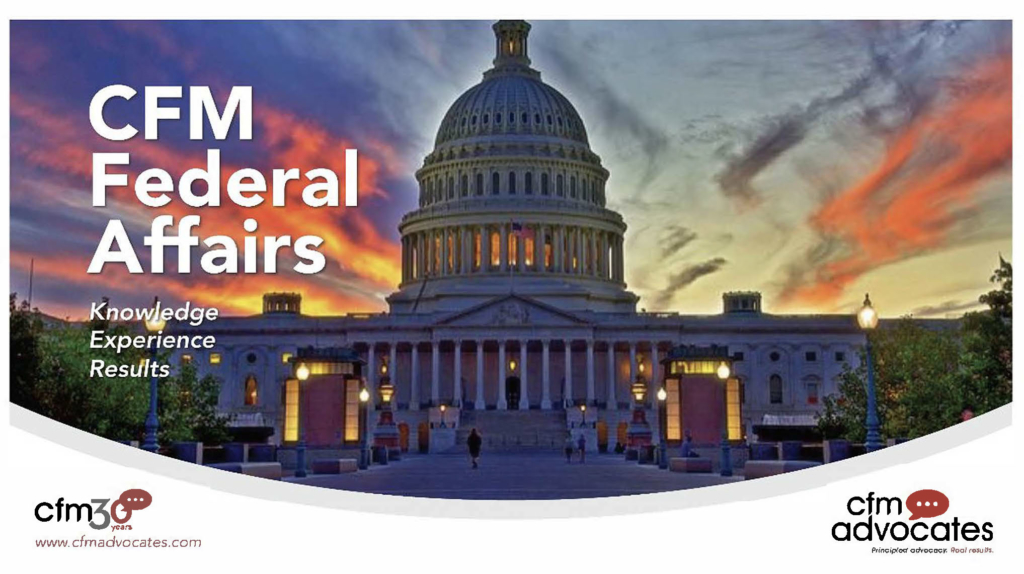
The President contracted COVID-19, two airlines furloughed 32,000 workers and Congress remained stymied on further coronavirus financial relief as economic recovery slowed down and the election loomed in 30 days. Not exactly just another typical week in Washington. This week could be its equal.
Last week started with a raucous presidential debate featuring more interruptions than punchlines. President Trump signed a continuing resolution to keep government running through December 11 on Thursday morning. That night, Trump tweeted he and the First Lady had tested positive for COVID-19. By Friday night, Trump was headed to Walter Reed Hospital and receiving experimental medications.
During the week, Speaker Nancy Pelosi and Treasury Secretary Steven Mnuchin seemed to inch toward an agreement on a new round of coronavirus financial assistance. The week ended with House Democrats approving a $2.2 trillion relief package, mostly a symbolic vote in frustration over the lack of a deal. Mnuchin’s offer topped out at around $1.6 trillion. Over the weekend, Trump tweeted about the relief package, saying he wanted “to get it done”.
October 1 had served as a deadline for a relief package because that’s when funding from the CARES Act mostly expired, including $25 billion for the airline industry. It was a deadline only observed by United Airlines and American Airlines with massive layoffs.
Unemployment continued its decline, but the economic recovery showed signs of slowing down, adding some urgency to negotiations for another round of aid. The Democratic bill would provide another round of $1,200-per-adult payments, enhanced unemployment benefits and more money for schools, health care and state and local governments, among many other things. It chopped roughly a third of the $3.4 trillion aid measure that the House passed in May, which was ignored in the GOP-controlled Senate.
Mnuchin’s latest offer to Pelosi was a $1.62 trillion package, including $250 billion for state and local governments, $186 billion less than Democrats want in their latest $2.2 trillion package, but $100 billion more than the White House offered in talks that broke down over the summer. On unemployment insurance, Mnuchin proposed a $400 per week federal benefit, retroactive to September 12 and lasting through January. That’s less than the $600 a week Democrats want, but $100 more than Senate Republicans have proposed.
If the parties can surmount state and local aid and unemployment insurance divisions, other gaps will likely be easier to bridge. For example, Mnuchin increased the GOP offer on education funding to $150 billion. Democrats are at $225 billion. Both parties started with around $100 billion for education earlier in the negotiations, but there’s general agreement needs have increased as schools across the country are at different phases of reopening for in-person learning.
Pelosi has talked frequently about the need for more money to expand COVID-19 testing and contact tracing, saying Republicans’ prior offer of $16 billion was a significant underestimate of the demand. Mnuchin’s offer to match Democrats’ $75 billion is a significant concession. Mnuchin also appears willing to match Democrats’ latest offer on food assistance with $15 billion for the Supplemental Nutrition Assistance Program and nutrition aid for low-income women, infants and children.
October 1 had served as a deadline for a relief package because that’s when funding from the CARES Act mostly expired, including $25 billion for the airline industry. It was a deadline only observed by United Airlines and American Airlines with massive layoffs.
The contentious debate on Tuesday created enough consternation that the Commission on Presidential Debates entertained rule changes, including a microphone mute button, to make the second and third scheduled debates more orderly and informative. Trump, who claimed he won the first debate, balked at rule changes. Moderator Chris Wallace said the President failed to abide by the rules his campaign team had agreed to in the first debate.
No one could predict whether Trump would recover from the virus in time for the next scheduled debate October 15, which will have a townhall format. Vice President Mike Pence and Senator Kamala Harris will debate on Wednesday in Salt Lake City.
The week’s upheavals didn’t dissuade Senate Republicans from pushing ahead on plans to hold confirmation hearings on October 12-13 for Trump’s Supreme Court nominee, Amy Coney Barrett, to fill the seat vacated by the death of Justice Ruth Bader Ginsburg. The confirmation appears nearly certain to proceed, despite Senators Mike Lee and Thom Tillis, both GOP members of the Senate Judiciary Committee, testing positive for COVID-19. Senator Ben Sasse, also a Republican member of the committee, is reportedly in protective isolation. Trump has urged quick confirmation of Barrett to firm up the conservative majority on the court in the event of an election-related challenge.
Lee, Tillis and Sasse may remain in isolation by the time confirmation hearings begin, prompting Senate Majority Leader Mitch McConnell to raise the prospect of remote attendance at the confirmation hearings. Barrett has met individually with a number of senators, including Lee.
The Rose Garden ceremony a week ago to announce Barrett’s nomination may have been the super-spreader event that led Trump, the First Lady, Lee, Tillis, Notre Dame’s president, Kellyanne Conway, Chris Christie and Trump’s press secretary to become infected. Four other Republican members of Senate Judiciary attended the ceremony. Administration officials noted Barrett and her husband contracted and recovered from the virus during the summer. Barrett tested negatively for the virus after the ceremony.
Trump’s medical team reported on Saturday that the President was hospitalized as a precaution. His physician said Trump’s high fever on Friday had subsided, his oxygenation rate was normal and there were no side effects from the medications he received. Trump received supplemental oxygen at the White House before being airlifted to Walter Reed Hospital. First Lady Melania Trump has remained at the White House to recuperate.
This week is a total wild card. McConnell wants to shut down the Senate, except for the confirmation hearings, for the next two weeks. Presumably, Trump’s weekend tweet may spur greater willingness to forge a compromise on coronavirus relief, requiring floor votes in the House and Senate. The vice-presidential debate will receive intense attention because of the age of the two presidential candidates.
The focus will stay glued to Trump, whether in the hospital or back at the White House, to mark his recovery. Medical experts say the seven to 10 days after testing positive for COVID-19 are the most critical. Coronavirus patients have experienced yo-yo symptoms, seeming to improve, only to become sicker during that 10-day period.




